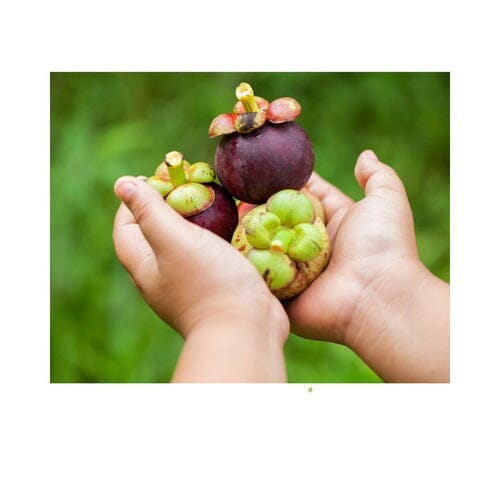Origin and history of the mangosteen
The mangosteen (Garcinia mangostana) originates from the rainforests of Southeast Asia, particularly Malaysia, Thailand, and Indonesia. The fruit has been prized in these regions for centuries and used in traditional medicine. Due to its rarity and exclusivity, the mangosteen was long considered the "queen of fruits" and reserved only for royal families.
Only in recent decades has the mangosteen spread to other parts of the world. Today, it is cultivated in various tropical regions and is increasingly available in Europe and North America. Despite its growing availability, however, the mangosteen remains an exotic delicacy appreciated by connoisseurs and gourmets.
Botanical characteristics of the mangosteen
The mangosteen tree (Garcinia mangostana) is an evergreen tree that can grow up to 25 meters tall. It belongs to the Clusiaceae family and is closely related to other Garcinia species. The tree's leaves are dark green, leathery, and glossy.
The actual fruit of the mangosteen is a berry with a thick, purple-red skin. When opened, the fruit reveals a white, creamy flesh divided into segments. Inside are one to six large, brown seeds.
The unique taste of mangosteen
The mangosteen is characterized by a unique, subtle flavor, often described as a blend of pineapple, peach, and lemon. The white flesh is very juicy, creamy, and slightly sweet and sour. Many connoisseurs rave about the perfect balance of sweetness and acidity that the mangosteen flavor offers.
To enjoy the mangosteen, carefully open the fruit by breaking it in half. The flesh can then be easily separated into individual segments and eaten directly. Be sure to remove the brown seeds before enjoying the fruit.
Nutritional value and health benefits of mangosteen
In addition to its unique flavor, the mangosteen also boasts an impressive nutritional profile. It's rich in vitamins, minerals, and phytochemicals that can provide numerous health benefits.
The xanthones contained in the peel, in particular, are considered potent antioxidants that can strengthen the immune system and have anti-inflammatory effects. Mangosteen also contains fiber, vitamin C, folic acid, and various minerals such as potassium, magnesium, and manganese.
Studies suggest that regular consumption of mangosteens could reduce the risk of cardiovascular disease, diabetes, and even cancer. Positive effects on brain function and stress reduction are also being discussed.
Buying and storing mangosteen
Although mangosteen has become increasingly available in Europe in recent years, it remains a rare and exotic fruit. At Obstwelt, however, we offer our customers fresh, high-quality mangosteens year-round.
When purchasing, make sure the fruit is firm, undamaged, and free of discoloration. Mangosteens with a glossy, purple-red skin are ideal. At home, store the fruit in the refrigerator at a temperature of 8-12°C. This way, they will stay fresh for up to a week.
Mangosteen in the kitchen
Mangosteens can be used in many different ways in the kitchen. The most popular way to enjoy the fruit is fresh. But mangosteens can also unleash their flavor in smoothies, desserts, salads, or even savory dishes.
Try a refreshing mangosteen sorbet or a delicious mangosteen tart, for example. The fruit also comes into its own when combined with yogurt, coconut, or chocolate. Let your creativity run wild and discover the diverse possibilities mangosteen offers.
Mangosteen at Obstwelt
At Obstwelt, we are dedicated to mangosteens and offer our customers the best this exotic fruit has to offer. Our mangosteens come from carefully selected growing areas and are harvested, transported, and stored with the utmost care.
Thanks to our many years of expertise and close relationships with producers, we can offer you premium-quality mangosteens. Order your fresh mangosteens from Obstwelt today and discover the queen of exotic fruits for yourself.
FAQ
What does mangosteen taste like?
Mangosteen tastes sweet and slightly sour, similar to a mix of lychee, peach, and strawberry, with a hint of citrus. Its creamy texture perfectly complements the exotic flavor.
Why is mangosteen so expensive?
Mangosteen is expensive due to limited growing areas, long growing season, sensitive storage, high transportation costs and high demand as an exotic delicacy.
How healthy is mangosteen?
Mangosteen is rich in antioxidants such as xanthones, vitamin C, and fiber. It strengthens the immune system, promotes digestion, has anti-inflammatory properties, protects the heart and cells from damage, and is low in calories—ideal for a healthy diet.
The mangosteen is considered the "queen of fruits" in Southeast Asia. Its white, segmented flesh is sweet, slightly tart, and reminiscent of a blend of lychee, peach, and a hint of vanilla. Here are two recipes that showcase the mangosteen's distinctive flavor in different ways:
Mangosteen smoothie with coconut water
Ingredients (for 2 glasses)
- 3–4 mangosteens , peeled and flesh removed
- 1 ripe banana (for creaminess and sweetness)
- 200 ml coconut water (alternatively: water or fruit juice)
- 1 tsp honey or agave syrup (to taste)
- A few ice cubes
preparation
-
Preparing the mangosteen
- Score the outer, dark purple skin of the mangosteen with a knife.
- Break the fruit apart, remove the white segments and remove any seeds (if present).
-
Mix
- Place mangosteen pulp, banana, coconut water and (if desired) honey in a blender.
- Add a few ice cubes if you want a cold shake.
- Blend everything into a creamy smoothie.
-
Season and serve
- If necessary, add a little more sweetness or liquid.
- Pour into glasses and enjoy immediately.
Tip : If you like it fresher, you can add some lime juice or mix in fresh mint leaves.
Mangosteen sorbet (without ice cream maker)
Ingredients (for approx. 4 servings)
- 5–6 mangosteens
- 2–3 tablespoons sugar (or other sweetener)
- Juice of 1 lemon (or lime)
- 100 ml water
- a few mint leaves or basil as garnish
preparation
-
Extracting mangosteen pulp
- Carefully cut open the skin, remove the white flesh and remove any seeds (if present).
-
Puree
- Finely puree the mangosteen pulp together with sugar and lemon juice.
- If seeds or fibers remain, strain through a sieve.
-
Mix the sorbet base
- Mix the puree with water until it reaches a smooth consistency. (You can add more or less sugar/water depending on the sweetness of the mangosteen and your taste.)
-
Freezing (without ice cream maker)
- Pour the mixture into a shallow metal bowl or casserole dish and place it in the freezer.
- Stir vigorously with a fork every 30 minutes to prevent large ice crystals from forming. Repeat this process for 2–3 hours until the sorbet has a creamy, frozen consistency.
-
Serve
- Form balls using a spoon or ice cream scoop.
- Optionally, garnish with a few mint leaves or basil. Enjoy immediately!
Tip : If you have an ice cream maker , you can process the sorbet mixture directly there until it is frozen creamy.

